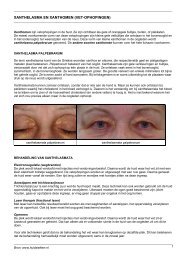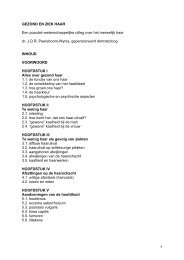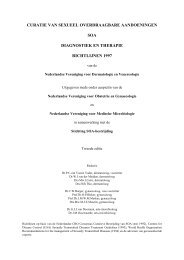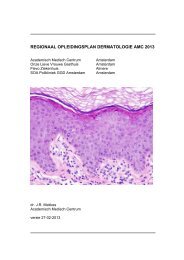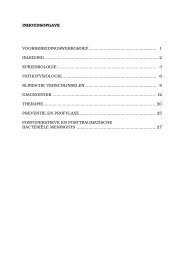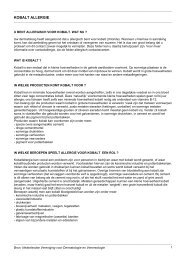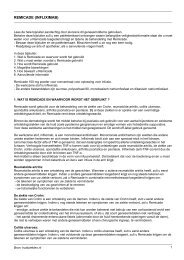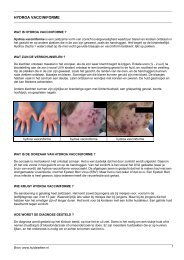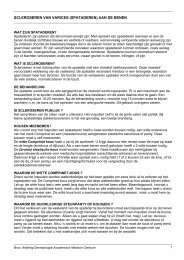Guidelines of care for the management of psoriasis ... - Huidziekten.nl
Guidelines of care for the management of psoriasis ... - Huidziekten.nl
Guidelines of care for the management of psoriasis ... - Huidziekten.nl
Create successful ePaper yourself
Turn your PDF publications into a flip-book with our unique Google optimized e-Paper software.
854 Gottlieb et al<br />
Table I. Moll and Wright 9 criteria <strong>for</strong> psoriatic<br />
arthritis<br />
d Polyarticular, symmetric arthritis (rheumatoid arthritis-like)<br />
d Oligoarticular (\5 joints), asymmetric arthritis<br />
d Distal interphalangeal joint predominant<br />
d Spondylitis predominant<br />
d Arthritis mutilans<br />
To meet <strong>the</strong> Moll and Wright 9 1973 classification criteria <strong>for</strong><br />
psoriatic arthritis, a patient with <strong>psoriasis</strong> and inflammatory<br />
arthritis who is seronegative <strong>for</strong> rheumatoid arthritis must present<br />
with 1 <strong>of</strong> <strong>the</strong> above 5 clinical subtypes. Moll and Wright 9 specificity<br />
is 98% and sensitivity is 91%.<br />
factor receptor positive neutrophils in PsA synovium.<br />
Angiogenesis is a prominent early event in both<br />
<strong>psoriasis</strong> and Ps. Elongated and tortuous vessels in<br />
both <strong>the</strong> skin and <strong>the</strong> joint suggest dysregulated<br />
angiogenesis resulting in immature vessels.<br />
High levels <strong>of</strong> tumor necrosis factor (TNF)-a, IL-8,<br />
IL-6, IL-1, IL-10, and matrix metalloproteinases are<br />
present in <strong>the</strong> joint fluid <strong>of</strong> patients with early PsA.<br />
Collagenase cleavage <strong>of</strong> cartilage collagen begins<br />
early in <strong>the</strong> disease and may result from cytokinedriven<br />
production <strong>of</strong> proteases. Treatment with anti-<br />
TNF-a <strong>the</strong>rapy is associated with changes in synovial<br />
macrophage subsets, reduction in T-cell and neutrophil<br />
numbers, and matrix metalloproteinase-3<br />
expression.<br />
Several findings suggest that osteoclast precursor<br />
cells play an important role in <strong>the</strong> pathogenesis <strong>of</strong><br />
PsA. Osteoclast precursor cells are increased in <strong>the</strong><br />
peripheral blood <strong>of</strong> patients with PsA and during<br />
treatment with anti-TNF agents, <strong>the</strong> frequency <strong>of</strong><br />
osteoclast precursors decreases significantly within 2<br />
weeks <strong>of</strong> initiating <strong>the</strong>rapy. A model has been<br />
proposed whereby elevated serum levels <strong>of</strong> TNF<br />
lead to an increase in <strong>the</strong> frequency <strong>of</strong> circulating<br />
osteoclast precursors. Osteoclast precursors <strong>the</strong>n<br />
migrate to <strong>the</strong> joint where <strong>the</strong>y encounter increased<br />
expression <strong>of</strong> receptor activator <strong>of</strong> nuclear factor<br />
kappa B ligand, which favors <strong>the</strong> differentiation and<br />
activation <strong>of</strong> osteoclasts. 7 Once <strong>for</strong>med, osteoclasts<br />
are exposed to a variety <strong>of</strong> activating molecules in<br />
<strong>the</strong> PsA joint, including TNF and IL-1 that trigger<br />
osteoclast activation that may, if unchecked, eventuate<br />
in osteolysis.<br />
PROGNOSIS<br />
The prognosis <strong>of</strong> PsA may range widely from a<br />
mild monoarthritic <strong>for</strong>m with a good prognosis to an<br />
erosive and destructive polyarticular <strong>for</strong>m with a<br />
poor prognosis, comparable in severity with that<br />
found in patients with RA. Although it is generally<br />
not possible to accurately predict which patients may<br />
JAM ACAD DERMATOL<br />
MAY 2008<br />
Table II. CASPAR criteria <strong>for</strong> <strong>the</strong> diagnosis <strong>of</strong><br />
psoriatic arthritis (modified 10 )<br />
The CASPAR (classification criteria <strong>for</strong> psoriatic arthritis)<br />
criteria consist <strong>of</strong> established inflammatory articular<br />
disease* with at least 3 points from <strong>the</strong> following<br />
features:<br />
A. Current <strong>psoriasis</strong> (assigned a score <strong>of</strong> 2; all o<strong>the</strong>r<br />
features are assigned a score <strong>of</strong> 1)<br />
B. A personal history <strong>of</strong> <strong>psoriasis</strong> (u<strong>nl</strong>ess current <strong>psoriasis</strong><br />
is present)<br />
C. A family history <strong>of</strong> <strong>psoriasis</strong> (u<strong>nl</strong>ess current <strong>psoriasis</strong> is<br />
present or <strong>the</strong>re is a personal history <strong>of</strong> <strong>psoriasis</strong>)<br />
D. Current dactylitis or history <strong>of</strong> dactylitis recorded by a<br />
rheumatologist<br />
E. Juxta-articular new bone <strong>for</strong>mation<br />
F. Rheumatoid factor negativity<br />
G. Typical psoriatic nail dystrophy including onycholysis,<br />
pitting, and hyperkeratosis<br />
*Prolonged morning or immobility-induced stiffness, and tender<br />
and swollen joints suggest an inflammatory joint disease.<br />
progress to disabling PsA, one study <strong>of</strong> 71 patients<br />
suggests that a polyarticular onset ( $ 5 swollen<br />
joints) <strong>of</strong> PsA may predict <strong>the</strong> appearance <strong>of</strong> erosive<br />
and de<strong>for</strong>ming disease over time, thus necessitating<br />
early intervention with effective <strong>the</strong>rapy. 8<br />
Much like RA, PsA can lead to chronic joint<br />
damage, increased disability, and increased mortality.<br />
Social and financial implications are also important,<br />
both in terms <strong>of</strong> personal loss and <strong>the</strong> impact <strong>of</strong><br />
direct (eg, medical <strong>care</strong>) and indirect (eg, inability to<br />
work) costs to <strong>the</strong> society and patient.<br />
CLASSIFICATION<br />
The classification <strong>of</strong> PsA is an area <strong>of</strong> ongoing<br />
international discussion. Although <strong>the</strong> 5 subgroups<br />
originally proposed by Moll and Wright 9 in 1973 are<br />
frequently used (Table I), considerable overlap between<br />
<strong>the</strong>se groups is now recognized. The recently<br />
developed CASPAR (classification criteria <strong>for</strong> PsA)<br />
criteria consist <strong>of</strong> established inflammatory arthritis,<br />
defined by <strong>the</strong> presence <strong>of</strong> tender and swollen joints<br />
and prolonged morning or immobility-induced stiffness,<br />
with a total <strong>of</strong> at least 3 points from <strong>the</strong> features<br />
listed in Table II. These CASPAR criteria have a<br />
specificity <strong>of</strong> 98.7% and sensitivity <strong>of</strong> 91.4% <strong>for</strong><br />
diagnosing PsA. 10<br />
The diagnosis <strong>of</strong> PsA is based on clinical judgment.<br />
Specific patterns <strong>of</strong> joint inflammation toge<strong>the</strong>r<br />
with <strong>the</strong> absence <strong>of</strong> rheumatoid factor and<br />
<strong>the</strong> presence <strong>of</strong> skin and nail lesions <strong>of</strong> <strong>psoriasis</strong> aid<br />
clinicians in making <strong>the</strong> diagnosis <strong>of</strong> PsA. Although<br />
<strong>the</strong>re are no specific serologic tests to confirm <strong>the</strong><br />
diagnosis <strong>of</strong> PsA, radiographs can be helpful <strong>for</strong><br />
diagnosis, to demonstrate <strong>the</strong> extent and location <strong>of</strong>



